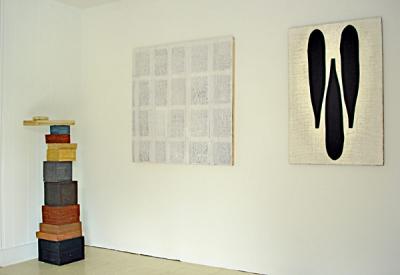Opinion: Lost, Fragmented, Evanescent

The walls are spare, painted black even, and the room would look like a tomb if the afternoon sun weren’t beaming in just so. It is what makes the show by Peter Sabbeth and Ross Watts at Sara Nightingale poetic and touching — trenchant, really, and not easy to forget.
The Water Mill gallery is showing the Sag Harbor-based artists, as the title suggests, “In Stereo,” the way really old record albums might have similar or different sounds coming out of two channels simultaneously. The experience is shared but slightly off, destined to be heard or seen together even with disparate sources.
If there is a problem with the show, it is that the work looks so well together in this installation that it is hard to pick one thing apart to examine in detail. Surfaces bounce off each other and then adhere somewhere else. Text is real or feigned, scrawled and rubbed out, or painstakingly cursive in a presentation that would have made second-grade teachers a generation ago very proud.
The sense of loss, time’s passage, outmoded and obsolete technologies, practices, and forms is inherent in these rooms. To drive home the point, Mr. Watts even entombs a book of art criticism, burying a relic perhaps a tad prematurely, but highlighting its inevitable obsolescence.
Mr. Sabbeth uses a scrawled linear means of expression that hints at handwriting but is actually mere expressive mark-making. You will find no words in his pieces, which might be drawn in charcoal, pencil, paint, ink, or crayon, on canvas or looseleaf binder paper. In the gallery installation he uses chalk on the black walls. Everything about it alludes to handwriting, but it is drawn and not written, symbolic but not allusive. It is about a mode of expression that has become lost to us. We no longer recognize the signatures and handwriting of our most intimate relationships, because they and we are no longer writing anything by hand. It has become a meaningless gesture.
He underlines the inherent frustration in his work with his titles, which also suggest or decry meaning. “Just a Painting, Buddha Says” stands for one painting and “Rough Draft/Final Version” is the title of multiple pages of scrawl mounted on linen. “All that You Can’t Leave Behind” is big and loose with a small notebook sheet, a fragment or figment of a larger point of view. “Dear John” suggests thwarted love, misunderstanding, and endless subtext. “Attack on Memory” brings forth the notion that all of these black and white empty ruminations are a trip down the dark corridor of one person’s mind.
Mr. Sabbeth’s works are set throughout the gallery, offering dialogue with his own pieces and those of Mr. Watts, who examines similar themes. Whether he painstakingly writes out passages from the 1960s book of art criticism or carves off cross-sections of a fish sculpture, Mr. Watts constantly appears to be alluding to something lost, fragmented, or evanescent. The lack of color in the gallery makes his one colorful piece, “Jacks,” glaring. “Jacks” is composed of cantilevered boxes pretending to be something other than what they are. Sometimes they are painted wood. In other places, they might be Styrofoam decorated to look like something else. There is balance and tension and the whole thing is ponderous, not from its weight, but from its layers.
Mr. Watts is very taken with surface and materials, and how they can be manipulated. He likes to bury burlap in plaster and sand it down, layer by layer, until the surface looks like bone or some sumptuous ceramic concoction. Into that surface he will cut the shape of a tar paper cross-section of a bass, deep black and matte, against the refined and slightly luminescent white surface of the sanded plaster. Without context it could look like rubbings of Iron Age tools. It certainly seems heavy and weighted, fraught. Another dense composition uses gesso and tape to a similar effect, but is black-on-black and more linear, also sanded, smooth and tactilely seductive.
But Mr. Watts also plays with words, burying them in a white box in the case of Brian O’Doherty’s “Inside the White Cube,” a collection of essays he wrote in Artforum in the 1960s and 1970s. You can’t see the book, the box is solid and painted white, in strange striated layers that look like accumulations of sediment. Practically everything in this room gives one the feeling of being on an archaeological dig. On the wall nearby is Mr. Watts’s handwritten excerpt from one of the book’s essays, “Notes on the Gallery Space.” It’s like unpacking a musty steamer trunk of associations, assertions, references, and meaning.
Even more potent are those pieces that delve into the form and format of the sheet of paper itself. Whether stacked in tense aggregations between metal frames or in looser compositions, Mr. Watts manages to subvert our experience of the formalist manifesto for paper in original ways. In “Notis,” he coats and abrades the surface, adding tracing and rubbings to capture the irregularities of the wall’s supporting surface as the piece was being manufactured. These primed and pumped sheets are heavy stock, made heavier with the density of their additions of surface material. He hangs them evenly, eight altogether, along two metal bars that jut out from the wall, forming a kind of shield or talismanic armor, to protect this fragile monument to things near extinction.
The show is on view through Dec. 8.
